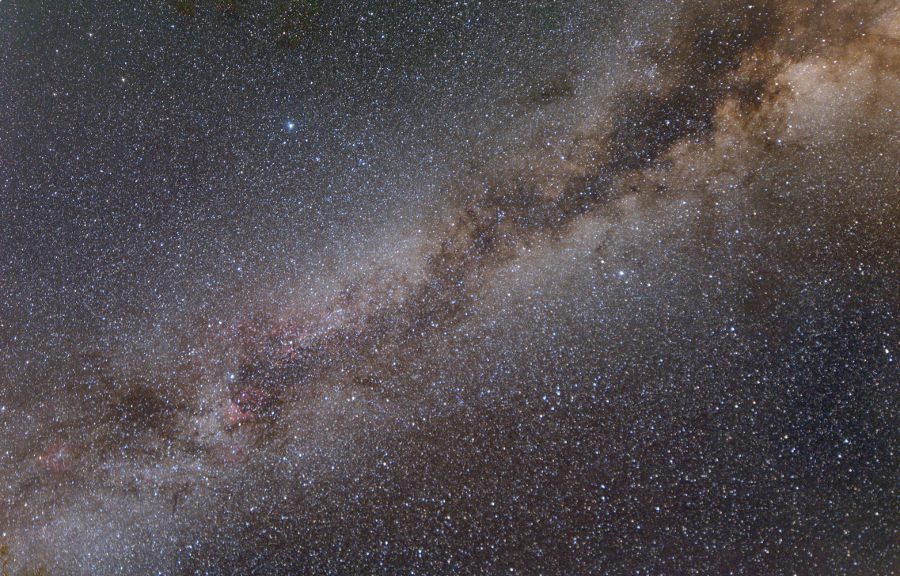Summer is traditionally a poor time for astronomy in the UK – it doesn’t really get dark in my location between late May and late July, and so I’ve not done a lot of astrophotography recently, though I have done a little bit of equipment work, cleaning, etc.
However, on a recent holiday to France (staying near St. Nathelène, near Sarlat-La-Caneda), I managed to do a little bit of widefield imaging work. I used a 350d and a couple of newly acquired lenses – a Canon 85mm f1.8 USM, and a Samyang 14mm. The 350d was modded when I bought it last year, though I have since added a Baader BCF filter to restore the focal point to allow me to use normal camera lenses with this camera body. One negative about this camera is that there are no 64bit drivers available, so I’m forced to run everything from inside a Virtualbox VM…(*)
Before the holiday, I built myself a camera mount for my GM8, based upon a spare dovetail I had. This has a Arduino driven stepper motor with a simple belt drive to focus the lenses – the system is based around the MyFocuserPro code using an Easydriver board. This has an ASCOM driver and can be nicely controlled from software like APT – this makes focusing relatively easy, though having liveview like on the 450d would be much easier!
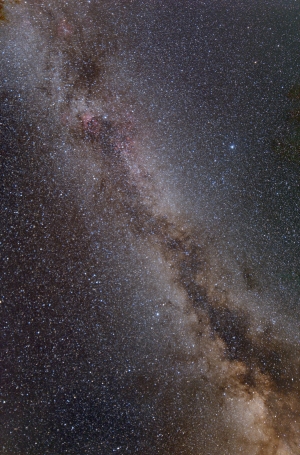 First up is a widefield image of the summer Milky Way, stretching from Lacerta to Scutum – this is a stack of 12x5min exposures, taken through the 14mm Samyang at f2.8. Reduction and processing was done using Pixinsight, with slight tweaking in Photoshop.
First up is a widefield image of the summer Milky Way, stretching from Lacerta to Scutum – this is a stack of 12x5min exposures, taken through the 14mm Samyang at f2.8. Reduction and processing was done using Pixinsight, with slight tweaking in Photoshop.
This was the first image I’ve taken through this lens, and the first widefield work I’ve done in about 20 years (!). The lens is not perfect (in fact I’ve replaced it with another example that is better and doesn’t show the coma on axis here which I think it’s due to element decentering), but it has still given me probably the best widefield shot of the Milky Way that I’ve produced: digital photography makes such shots much easier than slide film in some ways, but not others…! 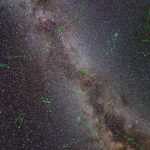 Clearly visible are the dark dust lanes (the Cygnus rift) as well as emission nebula such as IC1396, the North America Nebula, the Pelican Nebula, and the Gamma Cygni complex. From nova.astrometry.net here is an annotated version showing the major constellation outlines – interesting here is that even astrometry.net can’t handle the lens distortions from such a wide angle lens.
Clearly visible are the dark dust lanes (the Cygnus rift) as well as emission nebula such as IC1396, the North America Nebula, the Pelican Nebula, and the Gamma Cygni complex. From nova.astrometry.net here is an annotated version showing the major constellation outlines – interesting here is that even astrometry.net can’t handle the lens distortions from such a wide angle lens.
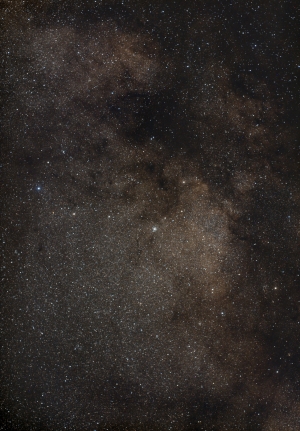 Second image is actually the first image I have taken with this camera – this using the 85mm EF f1.8 USM Canon lens (at f3.5). This is a shot of the area around the Scutum star cloud, M11, The Wild Duck Cluster and M26. It was “only” 4×180 seconds – clouds rolled through after this point, but it was a good learning experience (I’d close the aperture slightly more, and go for longer exposure). Nevertheless, I think I’ve managed to tease out some detail here, though gradients were tricky to handle using DBE in Pixinsight, along with some corrections in Photoshop. More exposure would have helped enormously here, and I think I can improve the capturing of calibration frames in future.
Second image is actually the first image I have taken with this camera – this using the 85mm EF f1.8 USM Canon lens (at f3.5). This is a shot of the area around the Scutum star cloud, M11, The Wild Duck Cluster and M26. It was “only” 4×180 seconds – clouds rolled through after this point, but it was a good learning experience (I’d close the aperture slightly more, and go for longer exposure). Nevertheless, I think I’ve managed to tease out some detail here, though gradients were tricky to handle using DBE in Pixinsight, along with some corrections in Photoshop. More exposure would have helped enormously here, and I think I can improve the capturing of calibration frames in future.
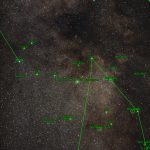 Similar to above, shown here is an annotated image (from nova.astrometry.net) to show exactly what is in the image, and which highlights some of the various deepsky objects around the field of view.
Similar to above, shown here is an annotated image (from nova.astrometry.net) to show exactly what is in the image, and which highlights some of the various deepsky objects around the field of view.
(*) – More recently, I’ve been looking at kstars and ekos for camera control – this looks promising and should allow control of the camera, mount and focuser using a Raspberry Pi.
